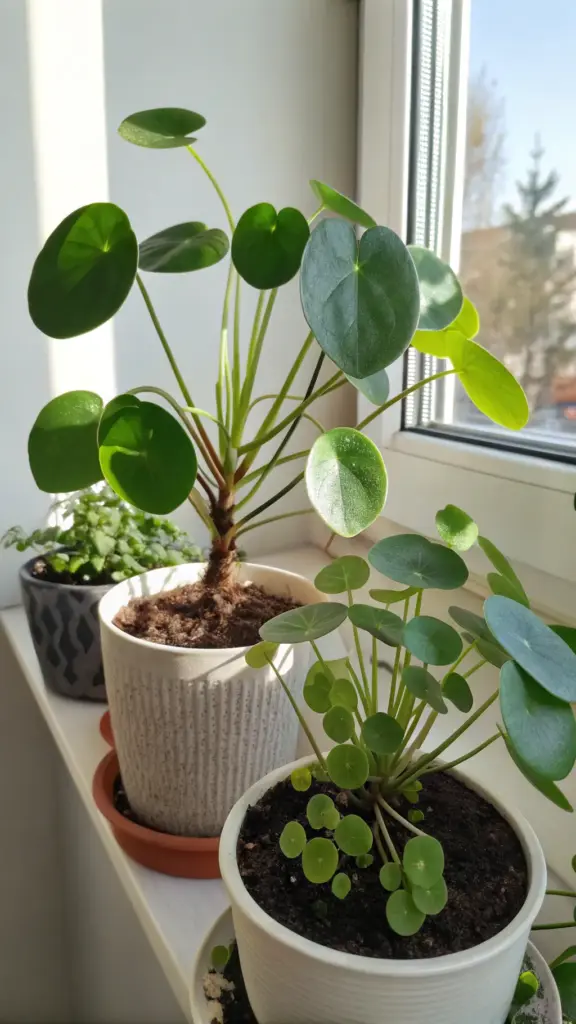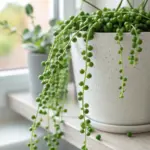4. They Propagate at the Perfect Time

I used to get so excited seeing tiny baby plantlets that I’d yank them off immediately. Big mistake – I probably killed a dozen babies doing this!
My first successful propagation didn’t happen until I learned to be patient. Timing is absolutely everything when it comes to Chinese money plant babies.
Now I’ve got three generations of plants from my original mama, and it all started with understanding when to actually remove those adorable little pups.
Spotting the Perfect Removal Time
Here’s the golden rule I wish someone had told me earlier: wait until the baby plantlet is at least 2-3 inches tall with several leaves of its own.
I used to think those tiny 1-inch babies were ready, but they need way more time to develop their own root system. Patience literally saves lives in the propagation game.
The baby should look like a miniature version of the mother plant, not just a few sad leaves poking out of the soil.
I check my plants weekly for new growth, but I resist the urge to remove babies until they’re properly established.
The Gentle Removal Technique That Works
Proper propagation starts with carefully digging around the baby with a clean spoon or small trowel. Don’t just pull – you’ll damage both plants.
I gently brush away soil until I can see where the offset connects to the mother plant. Sometimes there’s a little underground runner connecting them.
Use clean, sharp scissors to cut the connection rather than trying to twist or pull it apart. I learned this after accidentally tearing roots on several babies.
The baby should come away with its own little root system intact. If there are no roots, it’s not ready yet!
Preparing the Mother Plant for Success
Before I even think about removing babies, I make sure the mother plant is in peak health. Stressed plants don’t produce viable offspring.
I give my mama plant extra bright indirect light and consistent watering for about a month before propagation. A happy mother makes healthy babies – it’s that simple.
I also check that the mother plant has been in the same pot for at least 6 months. Recently repotted plants need time to establish before sharing energy with babies.
Sometimes I’ll even give a diluted fertilizer boost a few weeks before propagation to ensure the mother has plenty of nutrients.
Root Development and Early Care
After removing a baby, I plant it in my specialized soil mix (the same recipe from section 1) in a small 3-4 inch pot. Bigger pots actually stress young plants.
The first few weeks are critical – I keep the soil slightly more moist than usual but never soggy. New roots are super delicate and can rot easily.
I place baby plants in lower light than mature plants for the first month. They need time to establish without the stress of bright light.
No fertilizer for at least 6-8 weeks! Baby plants need to focus on root development, not leaf growth.
Creating Multiple Generations Successfully
My proudest plant parent moment was when my first propagated baby started producing its own babies. Three generations from one original plant!
The key to ongoing success is never removing all the babies at once. I leave at least one or two to mature with the mother plant.
Each generation seems to adapt better to my specific growing conditions. My third-generation plants are honestly more robust than the original.
I keep detailed notes about which plants came from which mothers – it helps me track which genetics work best in my home.
My Propagation Timeline Disaster
I once got impatient and removed six babies in one day from a single mother plant. The poor mama went into shock and dropped half her leaves.
Removing too many babies at once stresses the mother plant severely. Now I only take one or two babies per season and let the plant recover between removals.
The mother plant needs time to redirect energy back to its own growth after sharing resources with babies.
Seasonal Propagation Success
Spring and early summer are absolutely the best times for propagation. The plants are actively growing and babies establish faster.
I avoid propagating during winter when growth slows down. Those babies just sit there struggling instead of developing strong root systems.
Late summer propagation can work but the babies need extra care going into their first winter.
Ready to learn the pest prevention secrets that keep nursery plants looking perfect? Hit “next” to discover how pros stop spider mites and aphids before they even show up!









GIPHY App Key not set. Please check settings